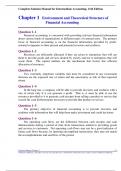Examen
Solution Manual For Intermediate Accounting, 11th Edition by David Spiceland, Mark Nelson, Wayne Thomas, Jennifer
Solution Manual For Intermediate Accounting, 11th Edition by David Spiceland, Mark Nelson, Wayne Thomas, Jennifer
Both online and in PDF Immediately available after payment . 100% Money Back Guarantee
[Montrer plus]
Dernier document publié: 1 année de cela
Publié le
1 février 2023
Fichier mis à jour le
3 septembre 2023
Nombre de pages
3525
Écrit en
2022/2023
Type
Examen
Contient
Questions et réponses
Établissement
Solution
Cours
Solution
Par: arogowski • 1 mois de cela
Par: calliham81 • 2 mois de cela
Par: qweraaa1351234 • 2 mois de cela
Par: hematyarfatemeh • 8 mois de cela
Par: rmfmonkey • 8 mois de cela
Par: davidgindi48 • 9 mois de cela
Par: apolinairebrown • 9 mois de cela
Afficher plus de commentaires
S'abonner
€17,29
Garantie de satisfaction à 100%
Disponible immédiatement après paiement
En ligne et en PDF
Tu n'es attaché à rien
Complete Solution Manual for Intermediate Accounting, 11th Edition Solutions Manual, Chapter 2 2–1 © McGraw Hill LLC. All rights reserved. No reproduction or distribution without the prior written consent of McGraw Hill LLC. Question 1 –1 Financial accounting is concerned with providing relevant financial information about various kinds of organizations to different types of external users. The primary focus of financial accounting is on the financial information provided by profit -




